Democratic Republic of the Congo
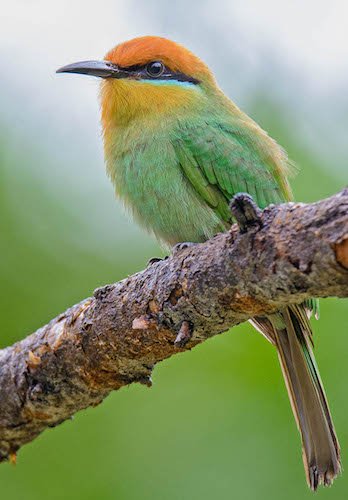
The Democratic Republic of the Congo (DRC) is a country in Central Africa. By land area, the country is the second-largest country in Africa and the 11th-largest in the world covering over 2,345,000 km2 (over 905,000 square miles). It straddles the Equator, with one-third to the north and two-thirds to the south. With a population of more than 111 million, the Democratic Republic of the Congo is the most populous nominally Francophone country in the world. The national capital Kinshasa is a mega-city of almost 18 million people, which is also the economic centre. The country is bordered by the Republic of the Congo; Central African Republic; South Sudan; Uganda; Rwanda; Burundi; Tanzania (across Lake Tanganyika); Zambia; Angola; the Cabinda exclave of Angola; and the South Atlantic Ocean.
As a result of its equatorial location, the DRC experiences high precipitation and has the highest frequency of thunderstorms in the world. The annual rainfall can total upwards of 80 inches in some places, and the area sustains the Congo rainforest, the second-largest rainforest in the world after the Amazon rainforest. This massive expanse of lush jungle covers most of the vast, low-lying central basin of the river, which slopes toward the Atlantic Ocean in the west. This area is surrounded by plateaus merging into savannas in the south and southwest, by mountainous terraces in the west, and dense grasslands extending beyond the Congo River in the north. The glaciated Rwenzori Mountains are found in the extreme eastern region.
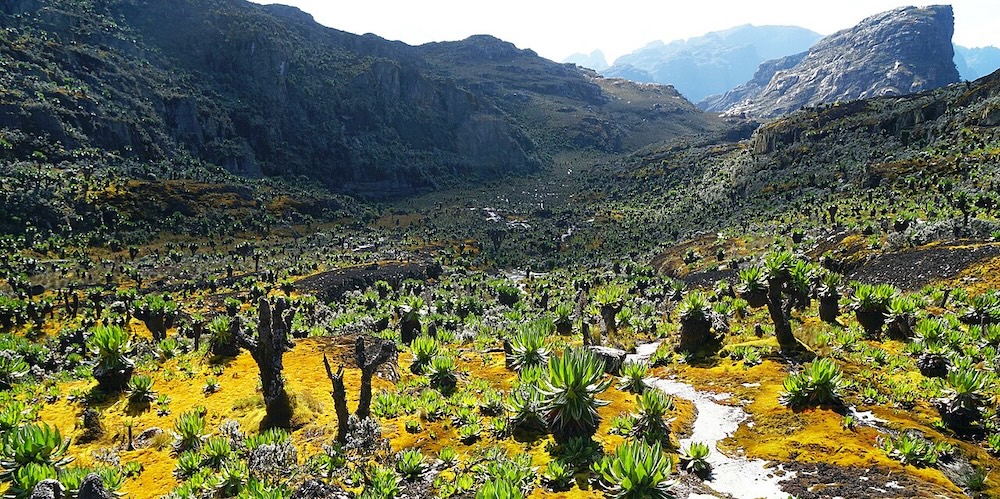
Rwenzori Mountains – ©Jontycrane CC BY-SA 4.0 via Wikimedia Commons
The tropical climate produced the Congo River system which dominates the region topographically along with the rainforest it flows through. The Congo Basin occupies nearly the entire country and an area of nearly 1,000,000 km2 (390,000 square miles). The river and its tributaries form the backbone of Congolese economics and transportation. Major tributaries include the Kasai, Sangha, Ubangi, Ruzizi, Aruwimi, and Lulonga.
The Congo River has the second-largest flow and the second-largest watershed of any river in the world (trailing the Amazon in both respects). The sources of the Congo River are in the Albertine Rift Mountains that flank the western branch of the East African Rift, as well as Lake Tanganyika and Lake Mweru. The river flows generally west from Kisangani just below Boyoma Falls, then gradually bends southwest, passing by Mbandaka, joining with the Ubangi River, and running into the Pool Malebo (Stanley Pool). Kinshasa and Brazzaville (Capital of Congo) are on opposite sides of the river at the Pool. Then the river narrows and falls through a number of cataracts in deep canyons, collectively known as the Livingstone Falls, and runs past Boma into the Atlantic Ocean. The river and a 37-kilometre-wide (23 mile) strip of coastline on its north bank provide the country’s only outlet to the Atlantic.
The Albertine Rift plays a key role in shaping the Congo’s geography. Not only is the northeastern section of the country much more mountainous, but tectonic movement results in volcanic activity, occasionally with loss of life. The geologic activity in this area also created the African Great Lakes, four of which lie on the Congo’s eastern frontier: Lake Albert, Lake Kivu, Lake Edward, and Lake Tanganyika. The rift valley has exposed an enormous amount of mineral wealth throughout the south and east of the Congo, making it accessible to mining. Cobalt, copper, cadmium, industrial and gem-quality diamonds, gold, silver, zinc, manganese, tin, germanium, uranium, radium, bauxite, iron ore, and coal are all found in plentiful supply, especially in the Congo’s southeastern Katanga region.
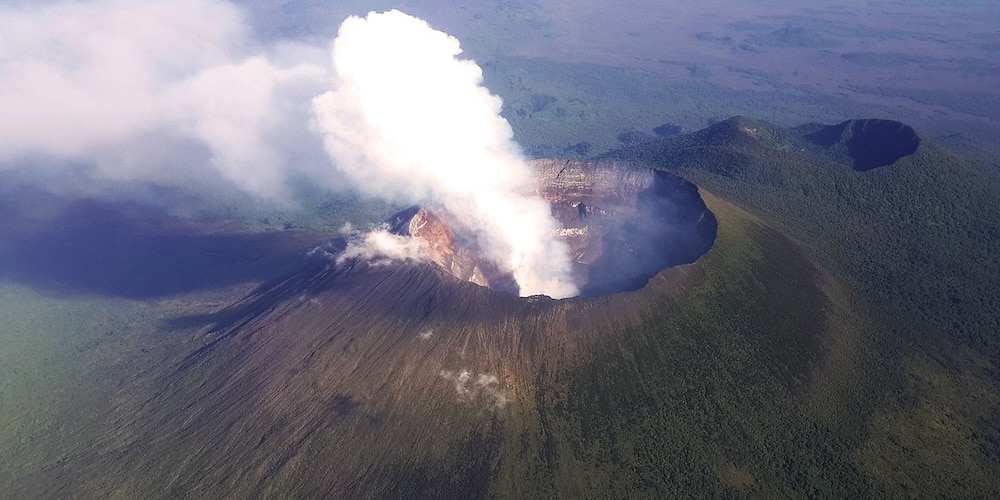
Mount Nyiragongo – ©MONUSCO/Neil Wetmore CC BY-SA 2.0 via Wikimedia Commons
Two active volcanoes, Mount Nyiragongo and Mount Nyamuragira, have both erupted several times this century.
Birding the DRC
The rainforests of the Democratic Republic of the Congo contain great biodiversity, including many rare and endemic species, such as the common chimpanzee and the bonobo (or pygmy chimpanzee), the African forest elephant, mountain gorilla, okapi, forest buffalo, leopard and, further south in the country, the southern white rhinoceros.
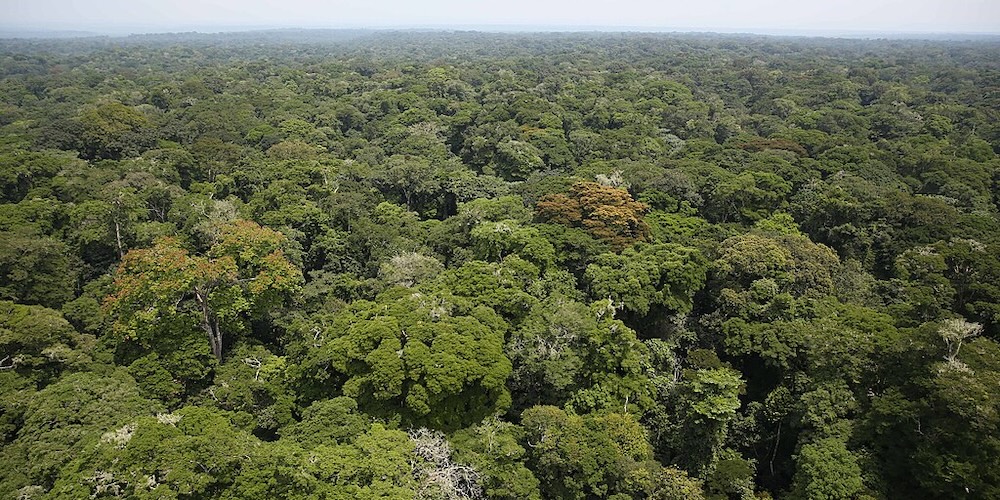
Ituri Rainforest – ©MONUSCO Photos CC BY-SA 2.0 via Wikimedia Commons
Five of the country’s national parks are listed as World Heritage Sites: the Garumba, Kahuzi-Biega, Salonga and Virunga National Parks, and the Okapi Wildlife Reserve. The Democratic Republic of the Congo is one of 17 Megadiverse countries and is the most biodiverse African country. Because of hunting and habitat destruction, the numbers of chimpanzee, bonobo and gorilla (each of whose populations once numbered in the millions) have now dwindled down to only about 200,000 gorillas, 100,000 chimpanzees and possibly only about 10,000 bonobos. Major environmental issues in DRC include deforestation, poaching, which threatens wildlife populations, water pollution and mining.
It is home for more than 10,000 types of plants, 600 timber species, as well as 1,000 bird species, 280 reptile species, and 400 mammal species, including the forest elephant, gorilla, forest buffalo, bongo, and okapi.
The avifauna of the Democratic Republic of Congo include a total of 1189 species, of which twenty-one are endemic, and one has been introduced by humans. This country has the greatest avian biodiversity of any African country.
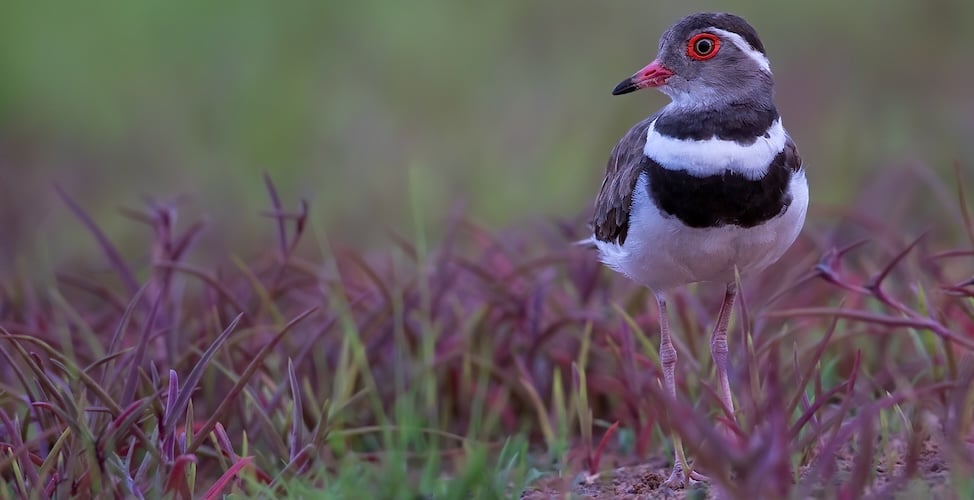
Forbe’s Plover Charadrius forbesi – ©Dubi Shapiro
Apart from the sought-after endemics, many Albertine Rift Valley species are also at the top of a potential visiting birder’s list of ‘must-see’ birds. Whilst the huge list, endemics and specials are greatly desired birding tourism is still in its infancy, not least because of the difficult access into the rainforest and continuing political unrest with armed insurgence around some top birding destinations like the Rwanda border.
-
Important Bird Areas
InformationStraddling the Albertine Rift and the Congo Basin, Kahuzi-Biega National Park is an exceptional habitat for the protection of the rainforest and the eastern lowland gorillas, Gorilla berengei graueri. Extending over 600,000 ha, are dense lowland rainforests as well as Afro-montane forests, with bamboo forests and some small areas of sub-alpine prairies and heather on Mounts Kahuzi (3,308 m) and Biega (2,790 m).The country also holds a high proportion of species restricted to a number of biomes: 228 out of 278 Guinea-Congo forest species; 93 out of 228 Afrotropical Highlands species; 47 out of 67 species of the Zambezian biome; 29 of the 54 Sudan-Guinea Savanna species and 9 of 12 species of the Lake Victoria basin biome.See African Bird Club Website for detailed information
-
Wikipedia
GNU Free Documentation License
https://en.wikipedia.org/wiki/Democratic_Republic_of_the_Congo
-
Number of bird species: 1196
(As at February 2025)
Number of endemics: 21
Congo Peafowl Afropavo congensis
Prigogni's (Itombwe) Nightjar Caprimulgus prigoginei
Schouteden's Swift Schoutedenapus schoutedeni
Congo Bay-Owl Phodilus prigoginei
Grauer’s Cuckooshrike Coracina graueri
Yellow-crested Helmetshrike Prionops alberti
Bedford's Paradise-Flycatcher Terpsiphone bedfordi
Itombwe Flycatcher Muscicapa itombwensis
Kabobo Apalis Apalis kaboboensis
Lendu Crombec Sylvietta chapini
Congo Martin Riparia congica
Prigogine's Greenbul Chlorocichla prigoginei
Sassi's Olive Greenbul Phyllastrephus lorenzi
Chapin's Mountain-Babbler Kupeornis chapini
Prigogine’s Double-collared Sunbird Cinnyris prigoginei
Rockefeller's Sunbird Nectarinia rockefelleri
Yellow-legged Weaver Ploceus flavipes
Lufira Masked-Weaver Ploceus ruweti
Upemba Masked-Weaver Ploceus upembae
Golden-naped Weaver Ploceus aureonucha
Black-lored Waxbill Estrilda nigriloris
-
Avibase
PDF ChecklistThis checklist includes all bird species found in Democratic Republic of the Congo , based on the best information available at this time. It is based on a wide variety of sources that I collated over many years. I am pleased to offer these checklists as a service to birdwatchers. If you find any error, please do not hesitate to report them. -
E-Bird
PDF ChecklistThis checklist is generated with data from eBird (ebird.org), a global database of bird sightings from birders like you. If you enjoy this checklist, please consider contributing your sightings to eBird. It is 100% free to take part, and your observations will help support birders, researchers, and conservationists worldwide. -
Wikipedia
Annotated ChecklistThis is a list of the bird species recorded in the Democratic Republic of Congo. The avifauna of the Democratic Republic of Congo include a total of 1188 species, of which twenty-one are endemic, and one has been introduced by humans. This country has the greatest avian biodiversity of any African country.
-
Birds of Western Africa
| By Nik Borrow & Ron Demey | Christopher Helm | 2014 | Edition 2 | Paperback | 592 pages, 266 plates with colour illustrations; colour distribution maps | ISBN: 9781472905680 Buy this book from NHBS.com -
Birds of Western and Central Africa
| By Ber van Perlo | Princeton University Press | 2003 | Paperback | 384 pages, 109 plates with colour illustrations; colour & b/w illustrations, 1500+ b/w distribution maps, colour maps | ISBN: 9780691007144 Buy this book from NHBS.com

Birds of Africa
Apple iOS | AndroidBirds of Africa was developed as an aid to conservation and is an asset of The African Bird Club. It is a guide to more than 2300 species of birds in 43 countries...Organisations-
African Bird Club
WebsiteThe Democratic Republic of the Congo, DRC (previously Zaire) has a bird list consisting of 1,139 species following the ABC checklist mentioned below. This is probably the highest species count for any African country. Since 1996 a civil war and political instability have impacted the habitat adversely as well as limiting opportunities for visiting birders. There is much of interest for the birder to see in the DRC, so one can only hope that opportunities to visit will increase in the future -
Birding the Democratic Republic of Congo
Facebook Page -
Democratic Republic of Congo Birding Association
WebsiteThe Democratic Republic of Congo Birding Association was formally constituted on March 3rd 1998 by Tommy Pedersen, with valuable help from Marc Languy and Greg Davies.The goal for this organization is to be a medium for people interested in the Congolese avifauna -
West African Ornithological Society
WebsiteThe West African Ornithological Society grew out of the Nigerian Ornithologists’ Society, which was founded in February 1964. Its object is to promote scientific interest in the birds of West Africa and to further the region’s ornithology, mainly by means of its journal Malimbus (formerly the Bulletin of the Nigerian Ornithologists’ Society). This journal is biannual and bilingual, a unique feature in Africa.The West African Ornithological Society grew out of the Nigerian Ornithologists’ Society, which was founded in February 1964. Its object is to promote scientific interest in the birds of West Africa and to further the region’s ornithology, mainly by means of its journal Malimbus (formerly the Bulletin of the Nigerian Ornithologists’ Society). This journal is biannual and bilingual, a unique feature in Africa.
Reserves-
*Protected areas of the Democratic Republic of the Congo
InformationSatellite ViewInteractive list of Biosphere Reserves, National Parks & Nature Reserves etc... -
NP Garamba
InformationSatellite ViewThe park's immense savannahs, grasslands and woodlands, interspersed with gallery forests along the river banks and the swampy depressions, are home to four large mammals: the elephant, giraffe, hippopotamus and above all the white rhinoceros… -
NP Kahuzi-Biéga
InformationSatellite ViewStraddling the Albertine Rift and the Congo Basin, Kahuzi-Biega National Park is an exceptional habitat for the protection of the rainforest and the eastern lowland gorillas, Gorilla berengei graueri. Extending over 600,000 ha, are dense lowland rainforests as well as Afro-montane forests, with bamboo forests and some small areas of sub-alpine prairies and heather on Mounts Kahuzi (3,308 m) and Biega (2,790 m). -
NP Maiko
InformationSatellite ViewIt lies in one of the most remote forest areas of the country and covers 10,885 km2 (4,203 sq mi). A new approach to conservation has been the implementation of compensation measures for Simbas willing to leave the Park. In 2010, FFI initiated the construction of health centers and schools in villages falling inside the zone of influence of the Simbas. The same year FZS launched an ambitious project aiming at turning the Simbas problem around by recruiting some of them as park rangers and allowing a de facto social reintegration which would directly benefit nature conservation in Maiko. -
NP Odzala-Kokoua
InformationSatellite ViewOdzala-Kokoua is an approximately 13,500-square-kilometre (5,200 sq mi) national park and biosphere reserve in northwestern Republic of the Congo, established in 1935. Odzala-Kokoua has approximately 100 mammals species, and one of the continent's most diverse primate populations. Approximately 440 bird species have been recorded in the park... -
NP Salonga
InformationSatellite ViewThe park is in an area of pristine rainforest[citation needed] about halfway between Kinshasa, the capital, and Kisangani. There are no roads and most of the park is accessible only by river. Notable birds include: the endemic Congo Peafowl Afropavo congensis, Yellow-billed Stork Mycteria ibis, and Black Stork Ciconia nigra as well as a good number of endemics. -
NP Virunga
WebsiteSatellite ViewVirunga National Park (covering an area of 790,000 ha) comprises an outstanding diversity of habitats, ranging from swamps and steppes to the snowfields of Rwenzori at an altitude of over 5,000 m, and from lava plains to the savannahs on the slopes of volcanoes. Mountain gorillas are found in the park, some 20,000 hippopotamuses live in the rivers and birds from Siberia spend the winter there… -
NR Western Congolian swamp forests
InformationSatellite ViewThis ecoregion, combined with the neighboring Eastern Congolian Swamp Forests, contains one of the largest continuous areas of swamp forest in the world… -
WR Okapi
InformationSatellite ViewThe Okapi Wildlife Reserve occupies about one-fifth of the Ituri forest in the north-east of the Democratic Republic of the Congo. The Congo river basin, of which the reserve and forest are a part, is one of the largest drainage systems in Africa. The reserve contains threatened species of primates and birds and about 5,000 of the estimated 30,000 okapi surviving in the wild.
Sightings, News & Forums-
eBird
SightingseBirding This Month
Guides & Tour Operators-
Explore Rwanda
Tour Operator -
Kabira Safaris
Tour Operatorhe Ultimate Congo Bird Watching Tours And Safaris with the Local experts. -
Mission Africa Safaris
Tour OperatorOur Vision is to become one of the very best tour companies in East Africa while supporting projects that enhance the lives of communities living near game reserves. -
Nyungwe Forest
Local Tour Operator -
Virunga NP
Local Tour Operator
Trip Reports-
2010 [09 September] - Sjef Öllers - Cameroon, Congo and Central African Republic
PDF Report..I more or less accidentally found a tour to Congo and Central African Republic offered by Steppes Travel. The tour schedule looked excellent with almost two weeks spent in the Dzanga-Sangha area and the adjoining Nouabalé-Ndoki national park. Although normally we don’t like joining group tours, the interesting tour schedule convinced us to give it a try…. -
2017 [09 September] - Mark Van beirs
PDF ReportWe did it again! On the fourth day of our stay at the Lomako-Yokokala Faunal Reserve, deep in the heart of Congo, we all managed to admire a splendid male Congo Peafowl on his roost! What a bird! This very special and decidedly unusual tour focused on two extremely rarely observed Congolese specialities: the truly enigmatic Congo Peafowl and our closest next of kin, the gentle Bonobo. -
2019 [06 June] - Mathias D’haen
PDF ReportI visited the Okapi Fauna Reserve (Reserve Faune Okapi, RFO) during the first week of June 2019 with the goal to try to see as many of the unique mammal and bird species that occur in the region. Moreover, I wanted to get an understanding of what it would take to see some of the more elusive species that I did not expect to see on a one-week trip -
2020 [04 April] - David Karr
PDF ReportKinshasa, Easter Birding Coronavirus Lockdown -
2020 [07 July] - David Karr
PDF ReportMbandaka, Equateur Province: ICCN Botanical Garden
-
Fatbirder - linking birders worldwide...
Skip to content
